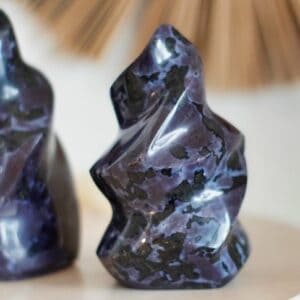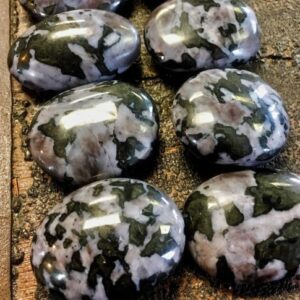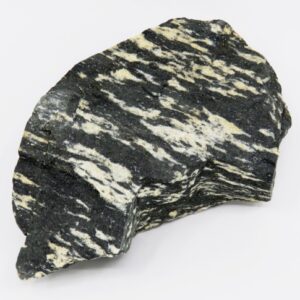Gabbro rocks are dark-colored, coarse-grained, intrusive igneous rocks. It’s typically dark green or black and primarily composed of Augite and Plagioclase.
Here’s a cool fact you might want to know, Gabbro is one of the most abundant rocks in the deep oceanic crust.
These rocks have various uses within the construction industry because they’re used in almost everything from crushed stone base materials to polished floor tiles and countertops. So, why are we talking about a rock used in construction material? Well, if you plan to dig for rocks and minerals then you need to be good at spotting host rocks or outcroppings. The better you are a surveying the land and the rock in it, the better you will be at finding great dig locations.
What Is Special About Gabbro?
Gabbros are stones of many uses! They often contain valuable amounts of nickel, gold, silver, chromium, platinum, and copper sulfides which make them ideal for mining companies to extract from the Earth’s crust.
In the construction industry, Gabbro is known under its trade name, black granite. The stone can be polished to a beautiful, deep black finish and you will typically see it used in kitchen stalls, facade stone, floor tiles, and cemetery signs. Gabbro is a highly desirable rock based on its durability and universal uses.
Gabbro rocks are also used to create various rough-cut products, including stones, paving stones, borders, and more. In some cases, it is used as aggregate or crushed stone which is kind of funny when you think about it. Polish it up and install a kitchen countertop to “woo” your neighbors or crush it up and add it to building materials.

Is Gabbro Rock Rare?
Gabbro rocks are among the most common in the oceanic crust, forming its lower portion. These stones represent slowly cooled crystal mushes that are primarily composed of plagioclase, olivine, and clinopyroxene.
Gabbro is actually relatively widespread and is found around the globe. While it sounds as though it might be easy to find, it is not all that common on the Earth’s continental crust. One must dive deeper into the lower portions of the oceanic crust. This ties into what I was talking about earlier. If you’re good at spotting host rock then you’ll be great at finding dig sites. This material is abundant under the surface but you can’t see it. However, there will be outcroppings where it pushes through and with it might be some desirable gems and minerals.
What Type of Rock Is Gabbro?
Gabbros are igneous rocks that are characterized by their mineral composition of pyroxene and plagioclase feldspar. When looking at the rock’s surface you’ll notice the very coarse-grained texture, with the crystals within the rocks being large and easily visible. Gabbro is also considered mafic.
The term Mafic is defined as “relating to, denoting, or containing a group of dark-colored, mainly ferromagnesian minerals, such as pyroxene and olivine.”

Is Gabbro Valuable?
They’re somewhat valuable because Gabbro can contain valuable minerals like copper, nickel, and platinum group elements (PGEs). Gabbro can be mined for these valuable resources of minerals, but these occurrences are incredibly rare. Not to mention, not all Gabbro will contain high enough concentrations of valuable minerals.
While Gabbro doesn’t always contain the more expensive minerals, it does have value in the construction industry.

Gabbro Rock Identification
Gabbro has a relatively distinctive look and is easily identified by its crystal structure. However, it’s often confused with various closely related rock varieties. When we’re not incredibly familiar with how specimens are defined and what they look like, it’s easy to misidentify them as something else entirely. If you’re constantly trying to identify rocks you’ve found then make sure you bookmark my rock identification resource page.
The first thing you’ll want to do to identify gabbro is to see if you can distinguish individual crystals with your naked eye. Keep your eye out for large amounts of whitish plagioclase feldspar. Dark, mafic minerals such as pyroxene hornblende make up between 40 to 90% of the specimen by volume. A gabbro specimen should have an overall color that’s gray or dark gray.
In order for a rock to be considered Gabbro, it must meet all of the following requirements and identifying markers.
- It must be igneous. It has to form from cooling magma with interlocking crystal grains.
- The specimen should be coarse-grained with a phaneritic texture containing crystals visible to the naked eye.
- The rock must meet the mafic mineralogy. At least 40 to 90% of the stone should contain dark, mafic minerals. The rest of the stone’s makeup is primarily plagioclase feldspar containing very little quartz.
- The specimen should be massive, meaning there are no internal structures or layering.
Suppose your specimen meets all of the above-listed criteria. In that case, it’s likely you have a gabbro or something that’s closely related. Rocks containing mineralogies similar to gabbro are considered Gabbroids, and many people group them all together when specific identification isn’t incredibly important.
Gabbro Rock Texture
One of the most defining features of gabbro stone’s appearance is its texture. All gabbro is coarse-grained, so we are able to see the individual crystals within the rocks. The phaneritic texture forms when magma cools slowly, allowing the crystals enough time to grow before they completely solidify.
While all gabbros are phaneritic, describing their texture in other ways is possible and common. Rocks can be described as having more than a single texture as long as the texture types aren’t mutually exclusive.
Most gabbro rocks are equigranular, meaning all of the crystals are approximately the same size. Gabbro rocks can be described as equiangular and phaneritic, but only if you can see similarly-sized crystals with the naked eye.
Some gabbro specimens can have a porphyritic texture, which indicates there are larger crystals (phenocrysts) in a groundmass of smaller crystals. If your specimen has large pyroxene crystals surrounded by smaller plagioclase feldspar crystals, it would be described as porphyritic and phaneritic.
- Identify Enstatite - March 12, 2024
- Identify Cerussite - March 3, 2024
- Identify Bytownite - February 18, 2024
